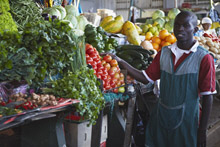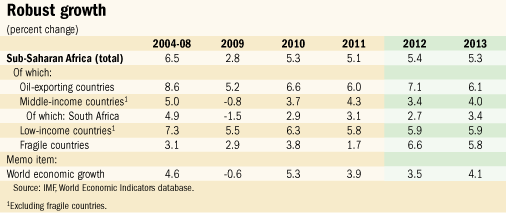
Typical street scene in Santa Ana, El Salvador. (Photo: iStock)
IMF Survey: Africa Sustains Growth Despite Global Uncertainty
May 14, 2012
- Most of sub-Saharan Africa expected to grow strongly this year, above 5 percent
- High inflation in some countries requires tight monetary policy stance
- Region's countries should gradually rebuild fiscal buffers where possible
Despite the weaker global economic environment, sub-Saharan Africa is expected to continue growing strongly in 2012.

Market in Maputo, Mozambique. Food price increases have contributed markedly to rising inflation in sub-Saharan Africa (photo: Trower/Harding/Corbis)
REGIONAL ECONOMIC OUTLOOK
GDP growth is forecast to increase slightly from the 2011 average of 5 percent, according to the IMF in its latest assessment of the region’s economy.
Sub-Saharan Africa has continued to enjoy robust growth (see table) as it is relatively isolated from the negative factors pulling down growth in most advanced countries, the IMF says in its Regional Economic Outlook for sub-Saharan Africa.
The region is also benefiting from one-off factors such as new natural resource production coming on stream, and recovery from drought and civil conflict in West Africa.
Strong growth prospects
Growth from domestic demand has been relatively self sustaining thanks to improved economic policies, higher foreign exchange reserves, and lower government debt. Rising levels of investment and consumption—particularly in the service sector—have been critical to growth.

But economic prospects differ across the region. Some middle-income countries—most notably South Africa—are performing less strongly because of their greater exposure to global developments, especially those in Europe.
In contrast, oil producers are projected to record robust growth because of new production coming on stream in Angola, and higher output levels in Nigeria and Chad. Finally, low-income countries are expected to continue enjoying strong growth of around 5½ percent.
In a background study published in the outlook, the IMF highlights the resiliency of sub-Saharan African financial systems. While confidence has been shaken in Europe by excessive government debt and vulnerable banking systems, sub-Saharan African financial systems have, so far, been generally insulated from global financial turmoil.
A second study reviews developments over the past decade in those countries where non-renewable natural resources are an important contributor to exports and government revenue. It considers the role played by natural resources in boosting incomes and the complex problems they present for macroeconomic management.
The outlook is subject to substantial downside risks. Renewed turbulence in euro area financial markets would adversely affect both exports and investment flows across the region. This would slow, but not derail growth in most countries.
A surge in oil prices, stemming from supply shocks, would pose serious challenges for oil-importing countries, squeezing real incomes and adding to external financing needs.
Inflationary pressures
Over the past year, several countries in Eastern Africa saw inflation spike and remain high for much of the year. Twelve-month inflation in the East African Community countries rose by almost 16 percentage points to over 20 percent during 2011, while Ethiopia experienced a surge from 15 percent to 36 percent over the same period.
Food price increases contributed significantly to this surge, although abundant local harvests helped to keep prices of staple foods low elsewhere in sub-Saharan Africa.
In response to the inflation surge, most countries adopted monetary tightening, with sharp increases in interest rates or tighter control of money supply helping to reduce inflation expectations. Despite receding in some of these countries, inflation still remains high in Ethiopia, Tanzania, and Uganda.
Going forward, monetary policy should remain focused on restoring price stability in countries still experiencing high inflation. In countries where inflation prospects are lower, a more accommodative stance might be advisable based on the strength of their recovery.
Rebuilding of fiscal space
In a large number of countries, fiscal policy contributed to the generally accommodative policy climate in 2011. But since 2008, fiscal buffers have been eroded in many countries and will need to be rebuilt over time.
Non-oil fiscal deficits declined in all oil exporting countries except for Cameroon and Gabon in 2011. This improvement is projected to continue this year. In contrast, the overall fiscal deficit widened by 1 percentage point in 2011 among low-income countries, although fiscal consolidation is expected to occur in about two-thirds of low-income countries in 2012.
Moreover, in many countries where deficits are expected to widen, large new capital investments are expected to account for much of the change (e.g., Ethiopia, Tanzania, and Rwanda).
Countries continuing to experience strong growth in 2012 are likely to have room for some fiscal consolidation to gradually rebuild fiscal buffers. Fiscal tightening would be premature in economies where growth remains weak and financing constraints are not tight.
In such countries, there may be room for a limited counter-cyclical response in the event of further adverse external shocks. Policy responses include maintaining existing spending plans in the face of lower revenue, and targeted additional support for the most vulnerable.
Medium-term agenda
Sustained improvements in people’s living conditions require a capable state apparatus, delivering essential services—such as security—and high levels of well-executed public investment in infrastructure and human capital.
It must also provide a favorable business environment as well as an efficient and stable financial system that supports private sector activity.
There have been significant improvements in sub-Saharan Africa over the past decade in improving both the capacity of the state—including its financing via greater revenue mobilization—and the environment for private sector activity.
Further progress in both areas will be needed if the strong growth over the past 10–15 years, which was stimulated by strong global demand for Africa’s natural resources, is to be sustained and become more broad based in the years ahead.







